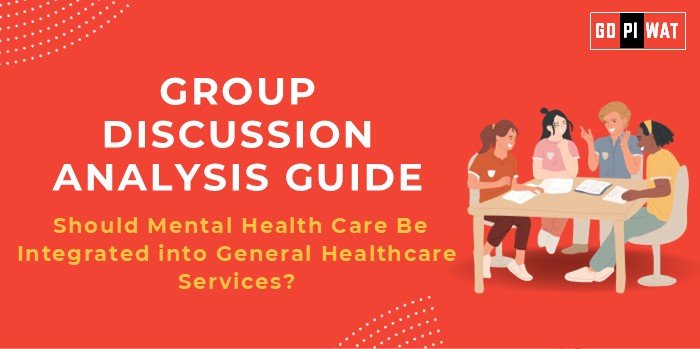📋 Group Discussion Analysis Guide: Should Mental Health Care Be Integrated into General Healthcare Services?
🌍 Introduction to the Topic
📖 Opening Context
Mental health is increasingly recognized as critical to overall well-being. Globally, 1 in 8 people live with mental health disorders, and the COVID-19 pandemic has spotlighted the urgency for integrated care.
📜 Topic Background
Historically, mental health has been siloed from general healthcare services due to stigma and resource constraints. Recent shifts emphasize a holistic healthcare model, advocating the integration of mental and physical health care for improved outcomes.
📊 Quick Facts and Key Statistics
- 🌍 Global Burden of Mental Health: Mental disorders contribute to 14% of the global disease burden (WHO, 2023).
- 💰 Economic Cost: Untreated mental health issues cost the global economy $1 trillion annually in lost productivity.
- 📉 Access Gap: In low- and middle-income countries, 75% of individuals with mental disorders receive no treatment.
- 🇮🇳 India’s Scenario: India has only 1 psychiatrist per 100,000 people, far below WHO recommendations.
🤝 Stakeholders and Their Roles
- 🏛️ Governments: Policy formulation, funding integration programs, and regulatory oversight.
- 🏥 Healthcare Providers: Delivery of inclusive services, training in mental health care.
- 🏢 Private Sector: Innovation in mental health technologies and insurance coverage expansion.
- 👥 Civil Society: Advocacy, destigmatization campaigns, and community support initiatives.
🏆 Achievements and Challenges
✨ Achievements
- 🌐 WHO’s Integration Model: Successful pilot projects like WHO’s Mental Health Gap Action Programme (mhGAP).
- 🇬🇧 National Mental Health Programs: Countries like the UK have integrated mental health into primary care with measurable success.
⚠️ Challenges
- 🔍 Stigma: Persistent barriers in both public perception and among healthcare providers.
- 🏥 Resource Shortages: Limited professionals and infrastructure.
- 💵 Funding Constraints: Mental health often receives less than 2% of healthcare budgets globally.
🌎 Global Comparisons
- 🇬🇧 UK’s NHS Model: Integrated mental health services in primary care since 2008.
- 🇿🇦 South Africa: Grassroots-level mental health interventions show promise.
📖 Case Studies
📜 India’s Tele-MANAS Initiative: Bridging mental health gaps through teleconsultation services.
💡 Structured Arguments for Discussion
- 👍 Supporting Stance: “Integrating mental health into general healthcare ensures holistic patient care and reduces the stigma surrounding mental illness.”
- 👎 Opposing Stance: “Integration risks overburdening already strained general healthcare systems, especially in resource-constrained regions.”
- ⚖️ Balanced Perspective: “Integration is vital but requires phased implementation, resource allocation, and public awareness.”
📈 Effective Discussion Approaches
🔑 Opening Approaches
- 📊 Highlight global statistics emphasizing the mental health burden.
- 📖 Use a case study like India’s Tele-MANAS to showcase innovative solutions.
🤔 Counter-Argument Handling
- 💡 Use comparative success stories to counter skepticism.
- 📚 Acknowledge challenges and propose phased integration plans.
🔍 Strategic Analysis of Strengths and Weaknesses
- 🌟 Strengths: Improves health outcomes, destigmatizes mental illness, and reduces economic costs.
- ⚠️ Weaknesses: Infrastructure gaps, limited professionals, and cultural stigma.
- 🚀 Opportunities: Leverage technology, expand insurance, and international collaboration.
- ⚡ Threats: Political apathy, budget constraints, and systemic inertia.
📚 Connecting with B-School Applications
- 🌐 Real-World Applications:
- 📋 Potential projects in healthcare management and policy innovation.
- 💬 Sample Interview Questions:
- 🧠 “How can mental health care integration address healthcare disparities?”
- 📡 “Discuss the role of technology in mental health integration.”
- 💡 Insights for B-School Students:
- 🤝 Understand stakeholder collaboration and propose scalable healthcare models.


